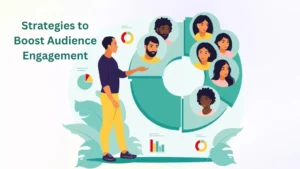Creating blog posts that genuinely engage your audience is the key to long-term success. Whether you’re just starting out or looking to improve your current strategy, these proven methods can help you boost engagement and connect with your readers on a deeper level. Let’s dive into these strategies!

Understanding Your Audience
Understanding your target audience is the foundation of each effective blog content. Knowing your audience allows you to personalize your content to their interests and requirements, ensuring that it resonates with them and generates significant engagement.
- Identifying the audience’s demographics and preferences: Start by learning about your target audience’s age, geography, interests, and issues. This information can help direct your content development, making it more relevant and impactful. For example, if your target audience is mostly young professionals, you could want to emphasize productivity suggestions, career growth, or work-life balance.
- Conducting Surveys and Feedback Sessions: Discover what your audience desires! Conduct surveys or seek feedback via comments, social media, or email. This can assist you learn their content preferences and offer you the knowledge you need to write blog posts that are engaging.
- Analyze Existing Engagement Metrics: Use Google Analytics to track which blog entries receive the most views, shares, and comments. Metrics like as time on page, click-through rates, and social media interaction can provide useful information about what your audience enjoys. Understanding these patterns allows you to fine-tune your content strategy and produce more of what your audience enjoys.
Crafting Compelling Content
After identifying your target audience, produce material that will keep them interested and returning for more. Creating useful and entertaining blog entries is critical for increasing audience engagement.
- Create Attention-Grabbing Headlines: The headline is the first thing readers see. A captivating headline will pique interest and promote clicks. Use figures, questions, or powerful adjectives to make your title stick out. For example, “5 Proven Tips for Better Blog Engagement” or “Why Your Blog Posts Aren’t Getting Read (and How to Fix It!)” could grab your readers’ interest.
- Structuring Posts for Readability: A well-structured blog post allows visitors to navigate your content simply. Break up long sections of material with subheadings, bullet points, and short paragraphs. This increases readability and keeps your readers interested. Don’t forget to use bold and italics to emphasize important points for your readers.
- Using visuals to enhance the message: Visuals are important in engaging readers. Use photos, infographics, charts, or videos to supplement your material. They not only make the content visually appealing, but they can also help clarify complicated information and offer context. For example, if you’re explaining a complex procedure, an infographic can simplify it into manageable steps.
Leveraging Interactive Elements
Engagement is more than simply publishing outstanding content; it’s about allowing your readers to interact with you. When you involve your readers in the process, you create a stronger relationship with them.
- Incorporating polls, quizzes, and surveys: Including interactive components such as polls, quizzes, and surveys encourage readers to actively participate. These elements not only make the content more enjoyable but also provide vital information about your target audience’s ideas and preferences. For example, a brief poll asking your audience what themes they want you to cover next will keep them interested while also providing you with ideas for future pieces.
- Encouraging Comments and Discussions: Comments are one of the most simple strategies to increase engagement. Ask questions at the end of your blog post or invite readers to express their ideas in the comments. Responding to comments demonstrates that you value your readers’ feedback and can stimulate additional debates, leading to increased engagement.
- Using Interactive Media such as Videos and Infographics: Videos and infographics are easily shared and may break down difficult information in an engaging manner. These sorts of media help readers retain content and are more likely to be shared across social platforms, expanding the reach of your site. Incorporating interactive media is an excellent method to improve the user experience and inspire additional involvement with your material.
Optimizing for SEO and Social Sharing
To increase interaction, your blog post should be easy to search and share. Proper SEO guarantees that your content reaches a broader audience and is more shareable.
- Using Relevant Keywords Naturally: Including relevant keywords in your blog post will help it rank better in search engine results. Incorporate keywords such as “blog post format,” “blog post examples,” or “blog post image size” into your text. However, avoid keyword stuffing; instead, produce relevant material that answers your viewers’ questions.
- Create Shareable Content with Strong CTAs: Making clear and engaging calls to action (CTAs) is critical for increasing engagement. Encourage readers to share your piece with their network, sign up for your newsletter, or download a useful resource. A CTA like “If you found this post helpful, share it with your friends!” can help you increase the reach of your material significantly.
- Time and Frequency of Blog Post Promotion: Don’t simply launch your blog and forget about it. Share your posts on social media several times, and try to post at different times of day to guarantee that your target audience sees them. The more exposure your blog receives, the more likely it is to attract a larger audience.
Building Community and Relationships
A dedicated, engaged audience is the foundation of your blog. Building relationships with your readers not only boost engagement but also builds trust and long-term commitment.
- Responding to comments and messages Promptly: Take the time to respond to comments and messages, whether on your blog, social media, or via email. A prompt answer informs your readers that you value their feedback and are actively involved in the community you’re creating.
- Highlighting User-Generated Content: Encourage readers to contribute to your site by writing testimonials, and guest pieces, or making social media mentions. Including their input not only increases engagement but also makes your readers feel valued and appreciated. This produces a positive feedback loop, increasing reader engagement and motivation to interact.
- Offer Exclusive Content or Benefits to Loyal Readers: Reward your loyal followers with exclusive content, early access to new postings, or special offers. By providing these rewards, you may make your readers feel unique and encourage them to return frequently. A loyal following is more inclined to share your material and spread the news to others.
Tracking and Refining Your Strategy
Engagement is a moving target, therefore you must review and adapt your strategy on a frequent basis to maintain improvement. By studying what works and what doesn’t, you can always improve your strategy to increase audience engagement.
- Monitor engagement metrics regularly: To track the performance of your blog, use programs such as Google Analytics. Look at measures like time on page, bounce rate, and social shares to see how well your audience interacts with your material. Regularly reviewing these indicators will allow you to detect patterns and change your strategy accordingly.
- Experimenting with various content formats and topics: Don’t be afraid to change things around. Experiment with various content styles, such as lists, how-to manuals, case studies, and opinion articles. This keeps your site fresh and encourages people to return for different types of material. You can also experiment with different topics to determine which ones resonate the most with your target demographic.
- Adapting Based on Analytics and Feedback: Review feedback and analytics on a regular basis to adjust your plan accordingly. If a post isn’t performing as intended, try changing the format or content to better suit your audience’s demands. Flexibility is essential for keeping your blog entries engaging and resonating with visitors.
Conclusion
Now that you’ve learned how to increase blog engagement, are you ready to take your material to the next level? Understanding your audience, writing interesting blog posts, and optimizing your content for SEO will help you create posts that not only attract but also keep readers interested over time. The key to success is consistency. Keep improving your plan based on feedback and statistics, and don’t be afraid to try different content formats or topics. With time, you’ll find the right balance that connects with your audience and encourages them to interact more. So, what is stopping you? Begin adopting these methods today and see your blog’s engagement increase.
